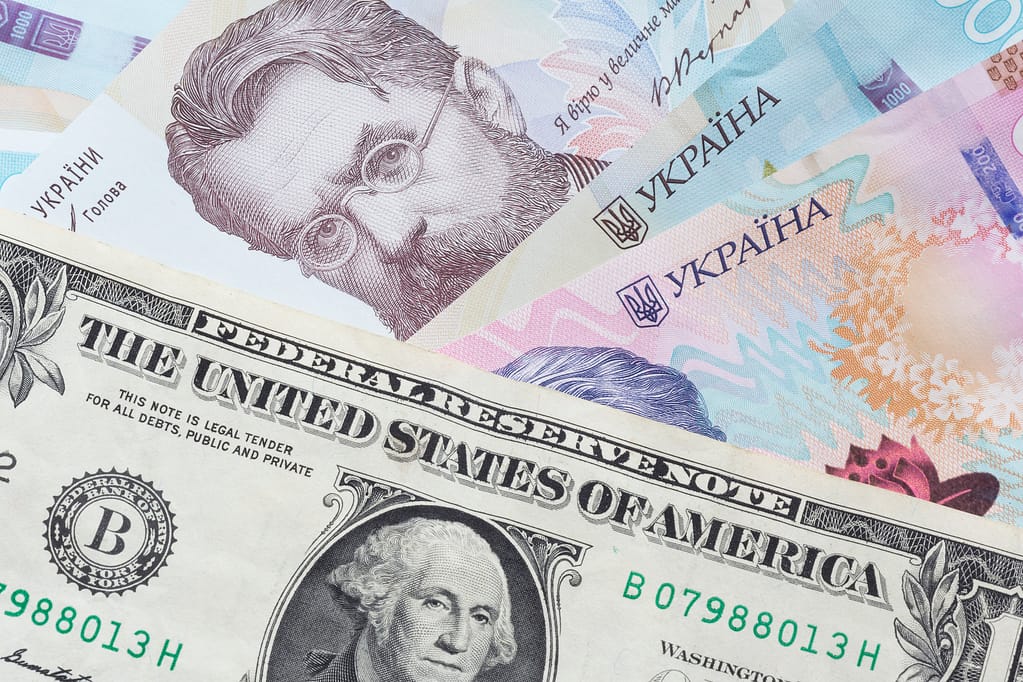Like it or not, we all depend on currency, whether for daily transactions, savings, or investments. It plays a crucial role in the functioning of modern economies. However, the currency is not immune to crises, which can significantly impact the economy, inflation, and personal finances. That’s why it’s important to understand what currency is, its different types, the causes of currency crises, and how to protect yourself during them.
Read on to find the answers to these pressing questions, as this article delves into the basics of currency and the world economy.

close up of one United States dollar banknote lying on Ukrainian hrivnya banknotes
Find HD, royalty-free currency visuals on Depositphotos for your commercial projects
What is currency in economics?

The Economic Times defines currency as a common denominator used to value goods and services. Simply put, it’s the system of money usually used within a certain country or region for the exchange of goods and services. Most often, currency comes in the form of banknotes and coins, serves as the physical representation of a country’s money supply, and is used in everyday transactions.
Currency is used not only for payments and trade facilitation but also as a unit of account that offers a consistent measure of value. It is also used to store value and become wealthy over time. Moreover, currency serves as a way to pay off debts and settle payments over time.
Main types of currency
There are currently three main types of currency:
- Fiat currency, the most common type these days, is issued by governments and not backed by a physical commodity. The currency’s value, in this case, comes from public trust in the issuing authority, and the most common examples of such currency are dollars and Euros.
- Commodity currency derives its value from the material it is made of. For instance, this could be gold or silver coins.
- Digital currency includes already-famous cryptocurrencies like Bitcoin, which operate on decentralized networks, and digital versions of fiat currency, such as central bank digital currencies (CBDCs).
What is a currency crisis, and what causes it?

different American world paper money as background. top view
A currency crisis is basically a drastic and prominent drop in the value of a country’s currency. This can cause lots of negative outcomes, the most significant of them being economic instability, financial distress, and even political crisis.
Why does this happen? The most common causes of a currency crisis include the following:
- Loss of investor confidence. Sometimes, investors lose confidence in a factor of a country’s market economic stability or its ability to maintain the value of its currency. In this case, they may start selling off the currency in large amounts, which, in turn, will cause rapid decline. This often happens when the country already has an excessive foreign debt or suffers from political instability.
- Balance of payment deficits. If a country suffers from persistent deficits (when imports significantly exceed exports) in its current account, this can lead to a depletion of foreign currency reserves. As a result, this puts pressure on the national currency and leads to devaluation.
- High inflation. When a country experiences high inflation, the purchasing power of its currency also declines. This leads to a loss of value relative to other currencies and can trigger a currency crisis as investors seek to move their assets into more stable currencies.
- Speculative attacks. There are also cases when currency crises are triggered by speculative attacks. In this case, investors start to anticipate a devaluation and begin selling currency in massive amounts. This can create a self-fulfilling prophecy, as the selling pressure forces the currency to devalue.
What’s more, these factors can often interact and reinforce each other. This also leads to a rapid devaluation of the currency.
How currency crisis causes inflation
Inflation is the rate at which the general level of prices for goods and services rises over time in an economy while the purchasing power of money decreases. Simply put, inflation leads to each unit of currency buying fewer goods and services than it did before.
A currency crisis can trigger inflation in a few key ways:
- Cost-push inflation happens when a currency loses value and makes imports more expensive. If a country depends a lot on imported goods, such a price increase can cause overall inflation.
- Demand-pull inflation can occur if money leaves the country during a currency crisis and the central bank starts printing more money to boost the economy. This increase can drive up demand and lead to inflation.
Inflation from a currency crisis can reduce purchasing power, making life harder for many people and, as a result, worsening the crisis.
How do you protect yourself from a currency crisis?
While there is no one-fits-all market solution, individuals can still take several steps to protect their finances.
The main ones are the following:
- Diversify your investments by spreading them across various assets and currencies. Pay special attention to stronger or more stable foreign currencies. For instance, the U.S. dollar and Swiss franc are considered to be some of the most stable currencies in the world.
- Invest in gold or other precious metals as they often preserve their value even during times of economic uncertainty.
- Consider investing in real assets such as real estate. Their value is often less affected by currency fluctuations, so this can guarantee you some level of confidence.
- Keep part of your savings in a foreign bank account denominated in a stable currency, if possible. This can provide easy access to funds that are insulated from a local currency crisis.
- Pay off debt in your local currency to avoid higher costs if the currency devalues. Currency crises often lead to higher interest rates, so debt becomes more expensive and difficult to pay off.
- Keep in touch with economic and political news that could signal a potential currency crisis. Educate yourself further on financial topics to be able to spot early warning signs and adjust your finances in this case.
To sum up
To successfully understand and navigate the details and challenges of currency in economics, you need to understand its functions and the potential risks associated with currency crises. You also need to know about the types of currencies available these days and strategies to mitigate risks and reduce the impact of potential currency crises. Use the information from this article to educate yourself and seek further knowledge because the more you know about currency, the more protected you become.






Leave a Comment